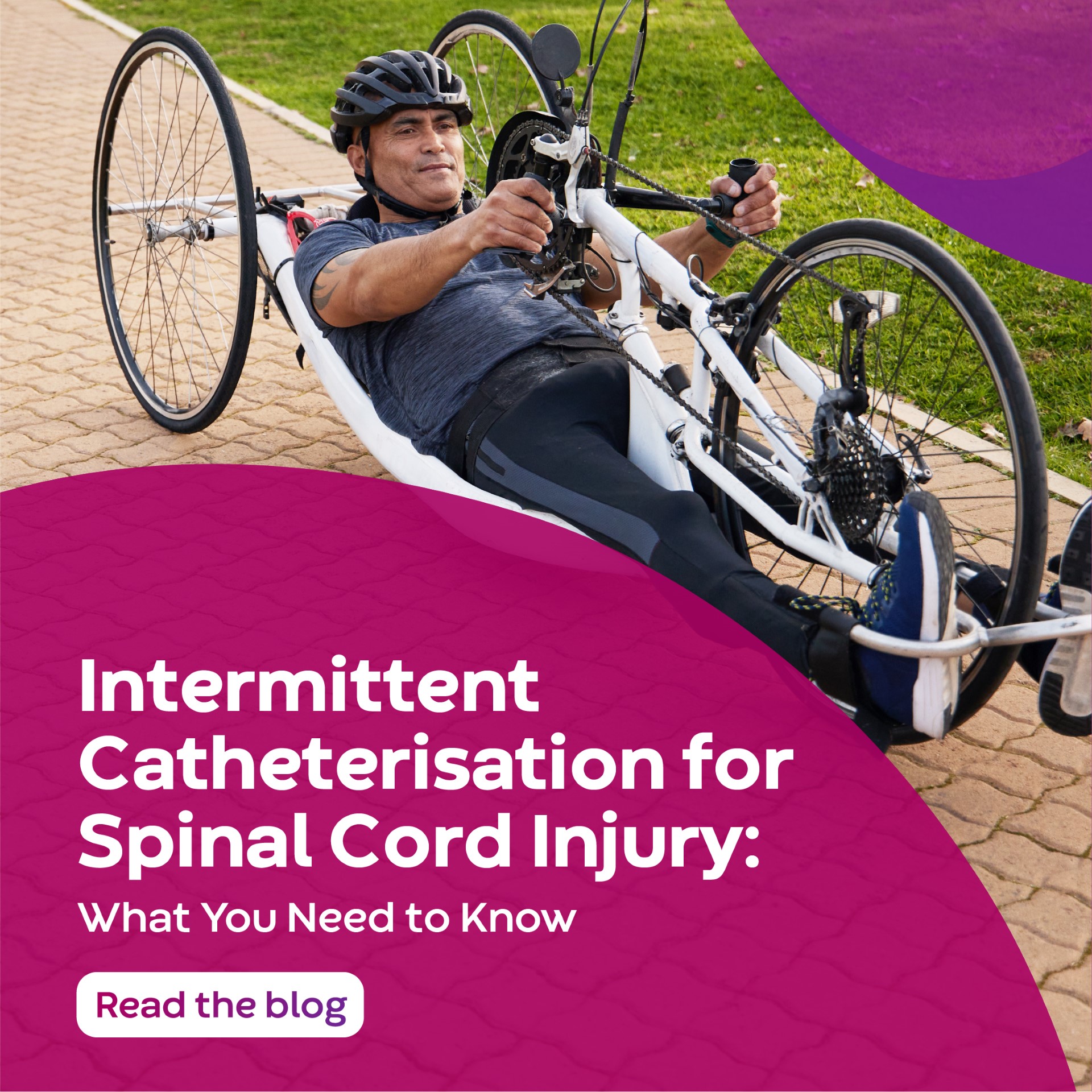Intermittent Catheterisation for Spinal Cord Injury
 ;
;
What You Need to Know
When we experience damage to the spinal cord, this can disrupt the communication between our brain and various parts of our body, including the bladder[14]. This means that, for some spinal cord injury patients, they experience urinary complications. Intermittent catheterisation (IC) can help address these issues by offering the patient more autonomous bladder management.
Types of spinal cord injury explained
Spinal cord injuries (SCIs) are categorised by the location of the injury, often by referencing affected vertebrae or segments. They fall into two primary categories: complete and incomplete injuries, each with various severity levels or ranges.
For example, tetraplegia, known as quadriplegia, is caused by an injury to the cervical spine (in the neck) that affects all four limbs[14]. Paraplegia is caused by damage to the thoracic spine (T1-T12) or lumbar spine (L1-L5)[14], which would affect the legs and lower body to varying degrees. There’s also anterior cord syndrome, caused by a blood supply issue to the anterior spinal artery resulting in motor paralysis below as well as loss of pain and temperature sensation[14].
What bladder problems can be caused by a spinal cord injury?
Because SCIs can disrupt the usual neural control of our body, this can lead to various issues referred to as ‘neurogenic bladder’. The severity of these varies, but some common complications associated with SCIs are:
- overactive bladder, where the bladder muscles contract too often or too forcefully, leading to frequent urination, urgency, and incontinence[14].
- underactive bladder, where the bladder muscles don't contract strongly enough or often enough, leading to difficulty emptying the bladder, urinary retention, and urinary tract infections[14].
- detrusor-sphincter dyssynergia, where the bladder muscles contract and the sphincter muscles relax at the same time, leading to urinary incontinence and urinary retention[14].
- urinary retention, where the bladder doesn't empty completely leading to urinary tract infections and kidney damage[14].
- urinary incontinence, where there is involuntary leakage of urine caused by overactive bladder, underactive bladder, or detrusor-sphincter dyssynergia[14].
How do I choose the right catheter after a spinal cord injury?
As we’ve seen, every SCI is different, leading to a wide array of different bladder control needs as well as unique and individual circumstances around mobility. As such, it’s important to select your catheter in consultation with a healthcare professional.
Things you’ll want to consider are:
- getting a catheter that’s the right size and length for your body
- your level of mobility and dexterity - if you’re a wheelchair user, you might prefer a closed-system catheter; other catheters cater to users who experience limited dexterity
- level of activity - if you’re out and about and can’t guarantee a controlled, clean environment, a no-touch catheter like a GentleCath Glide will help minimise risk of infection[14]
- size is also important, as the diameter of your urethra will affect your choice
So there are already quite a few factors to consider, and there’s no better person to talk to than your doctor so you can make a choice that will be comfortable and easier to use.
Learning How to Self-Catheterise After Spinal Cord Injury
Your first stop should be your doctor or nurse, as they will be able to teach you the basics and point you towards reliable resources. You could also reach out to peers who have similar, and longer, experience: building or joining a community and benefitting from their knowledge is a great way to foster those essential skills early on and know you’re getting the right information whilst also allaying any fears or stigma you might be experiencing with this new routine.
Learning good hygiene skills will also be an important step in performing self-catheterisation safely and successfully. Your healthcare team and community are a great first step here, and you can also access handy video guides like this one here.
Are there any adaptive tools that can help?
For individuals with spinal cord injuries looking at self-catheterisation, adaptive tools can make your catheterisation experience much smoother and more manageable.
Catheterisation aids you might consider are:
- catheter insertion aids that help safely grip a catheter if your level of dexterity requires that extra bit of assistance
- mirror systems to allow for easier self-examination
- wheelchair-mounted devices that can help hold catheter bags, guide catheters, and help keep them clean and in place
Are you a catheter expert yet?
Don’t worry if you still have more questions or are still a little confused as to whether you need a catheter or which one is right for you. If you or someone you know could benefit from the use of intermittent catheters, we invite you to explore our range of high-quality products on our Gentlecath intermittent catheter product page.
Why not begin your search now?
In conclusion, your chances of finding better bladder management for your spinal cord injury can only improve once you begin your search, arming yourself with the latest knowledge.
Understanding intermittent catheterisation in the context of an SCI is your pathway to improved bladder health and a better quality of life.
To better equip yourself with information about the right intermittent catheterisation products for your needs, we invite you to explore our wide range of IC products. Along with medical advice from professionals and your community, it’s a great first step.
[14] NHS. (2023, February 3). Living with Urinary catheter. https://www.nhs.uk/conditions/urinarycatheters/living-with/
Blogs
